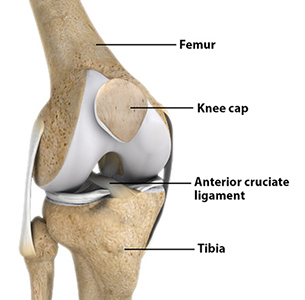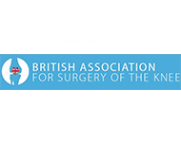Anterior Cruciate Ligament ACL Reconstruction
Introduction

The anterior cruciate ligament (ACL) is a ligament that provides stability to the knee joint. It is commonly injured during high-intensity sports. Surgery is often recommended to restore knee strength and function by reconstructing a damaged ACL with a graft. The graft may be obtained from the tendon that stabilizes the kneecap or patella and is called a “bone-patellar tendon-bone” graft or BPTB graft, as it consists of tendon and bony attachments.
Disease Overview
The thigh bone and shin bone are connected by a group of ligaments that provide stability to the knee. These include the anterior and posterior cruciate ligaments that run through the centre of the knee and cross each other diagonally. Together, they function to control the back and forth movements of the knee. The ACL, situated more in front, prevents the shin from slipping forward and provides stability during rotational movements. Intense stress on the ACL due to accidents and sports injuries may cause it to stretch or tear. ACL injuries may also be accompanied by injury to cartilage or other ligaments and tissues in the joint.
Indications
Knee injuries that involve the ACL usually cause complete or near complete tears that require surgical reconstruction with a graft to prevent instability and restore function to the knee. The “bone-patellar tendon-bone” graft has good strength and longevity and is recommended for those who wish to return to a high level of activity.
Surgical procedure
ACL reconstruction is usually performed 3-8 weeks after an injury once swelling has reduced and range of movement is improved through rehabilitation. This prevents stiffness and scar formation after surgery. The patellar tendon is examined prior to the procedure to see if it is fit to be used as a graft.
The procedure is performed under general or local anaesthesia. Your doctor will first evaluate your knee under anaesthesia to assess the damage to the ACL and other structures. Following this, a portion of the patellar tendon along with its area of attachment to the shin bone and kneecap is obtained and prepared to be used as a graft. Small incisions are then made over the knee to insert an arthroscope and other surgical instruments. The arthroscope consists of a tube with a light and camera to view the inside of the joint. The structures within the knee are evaluated and any significant injuries are identified and repaired during the surgery. Tunnels are created by drilling through the shin bone and thigh bone. The graft is passed through these tunnels and secured with screws to replace the original ACL. The incisions are then closed with sutures and covered with dressings. The procedure takes about 1-1/2 to 2 hours.
Post-Operative Care
Following surgery, you will have some pain and swelling for which your doctor will prescribe medications to keep you comfortable. Ice application and leg elevation is recommended to control swelling. Knee movement and weight bearing are encouraged as soon as possible. Physical therapy will be recommended to improve strength and movement.
Advantages & Disadvantages
ACL reconstruction with a “bone-patellar tendon-bone” graft has the advantage of better outcomes when compared to other forms of therapy or other grafts and the patellar graft is also easily obtained.
Disadvantages of this surgery include pain in front of the knee, especially with kneeling, from harvesting the patellar tendon. The procedure is not recommended for children with growing bones.
Risks and complications
As with any procedure, ACL reconstruction with bone-patellar tendon-bone graft is associated with certain risks and complications that include:
- Failure or tear of the graft
- Knee instability
- Knee pain
- Joint stiffness
- Loss of sensation due to nerve damage
Summary
Most ACL injuries require reconstruction with a suitable tendon graft to restore function and stability. The ‘bone-patellar tendon-bone’ graft provides excellent fixation, strength and durability enabling you to quickly return to your athletic activities following adequate rehabilitation.
Click here to view the frequently asked questions.





